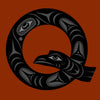Collector Kachina: Angak’china (Long Hair) Kachina, 1988 by Clifford Bahnimptewa (1938-1984), Hopi
Regular price
$2,800.00
Sale
Angak’china (Long Hair) Kachina, 1988
by Clifford Bahnimptewa (1938-1984), Hopi
cottonwood, feathers, wool warn, pigment
16" tall x 5" wide x 6.5" deep
In Native American culture, long hair is admired and respected. This is what makes Longhair, or Angak’china, a perfect example of a true Hopi Katsina. He features the traditional Hopi hairstyle worn by men.
The purpose of the Longhair Katsinam is to provide rain to the Hopi villages. They arrive in the villages in groups, often accompanied by Yellow or White Corn Maidens. They sing beautiful melodies for all, carrying optimistic themes and messages encouraging living life to its fullest. A true beacon of positivity, Longhairs are cherished as favorites among the Hopi Katsinam.
In addition to raising spirits by way of song, Longhair Katsinam perform a dance that usually brings a pleasant rainfall to nourish the earth and help crops to grow.
Their appearance is largely symbolic of their role in society. Their long, flowing hair and beards, for example are representative of the rain they inspire to fall. Eagle fluffs are worn to symbolize cloud bursts as the source of that rain. Their backs are often adorned with feathers to represent prayers for rain.
Clifford Bahnimptewa was born in 1938 at Old Oraibi on Third Mesa. He was best known for his Katsina paintings, as well he was a fine carver. He grew up around his paternal grandparents, John and Mina Lansa, village leaders who possessed vast knowledge of Hopi history and culture. Clifford is the father of Danny Lansa Bahnimptewa, Larson Bahnimptewa, Roland Bahnimptewa, Steven Bahnimptewa, and cousin of Jacob Bahnimptewa.
In 1968, with encouragement from Sedona trader Don Hoel, Clifford embarked on a three-year effort to paint the 286 Katsina dancers listed in Dr. Harold S Colton's book Hopi Kachina Doll with a key to their Identification. About 237 of Clifford’s paintings were published as illustrations in Barton Wright's book, Kachinas, A Hopi Artist’s Documentary. Author Theda Bassman concluded. "The series is a significant account of one man's understanding of his traditional religion in a time of change."
In 1995, American Indian Art Magazine honored him posthumously as one of the greatest Native American artist in history.





